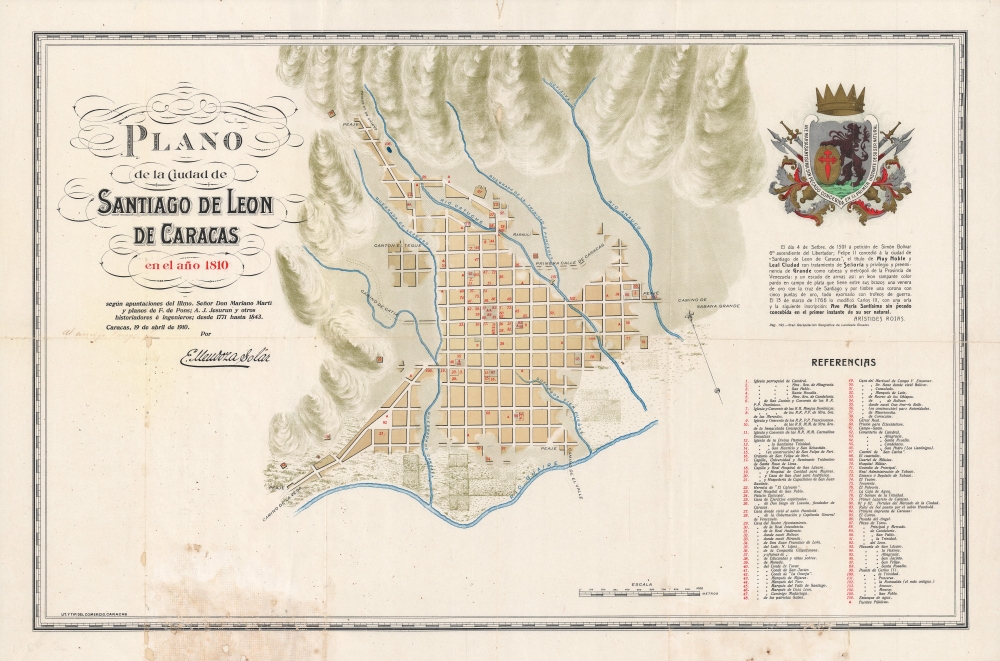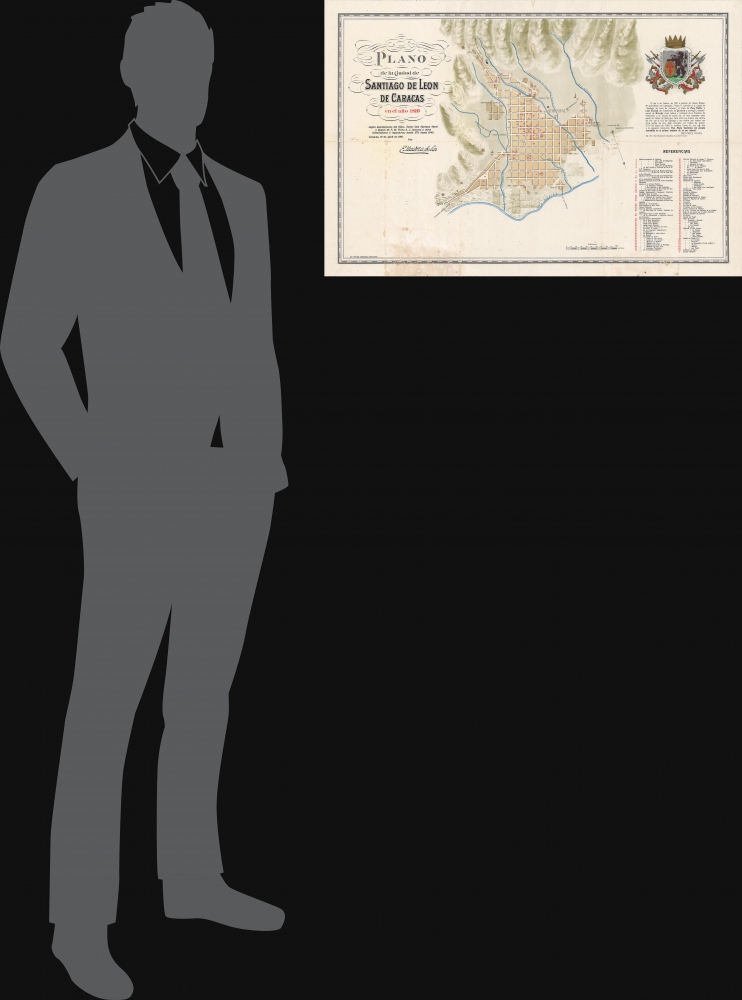1810 / 1910 Mendoza Solar Map of Caracas, Venezuela
Caracas-mendozasolar-1910$1,800.00

Title
Plano de la ciudad de Santiago de Leon de Caracas en el ano 1810 segun apuntaciones del ilustrisimo Senor Don Mariano Martin y planos de F. de Pons; A.J. Jesurun y otros, historiadores e ingenieros, desde 1771 hasta 1843.
1910 (dated) 20 x 30 in (50.8 x 76.2 cm) 1 : 11250
1910 (dated) 20 x 30 in (50.8 x 76.2 cm) 1 : 11250
Description
A scarce, unrecorded map of Caracas, Venezuela published in 1910 by Enrique Mendoza Solar and printed by Litografía y Tipografía del Comercio in Caracas. It celebrates the centenary of the Revolution of April 19, 1810, which ousted the Spanish colonial government, leading to a formal Venezuelan declaration of independence the following year.
Oriented towards the north-northwest, coverage includes the entire colonial town of Caracas on the banks of the Río Guaire and its tributaries. More than 100 locations are marked and indexed at right, including churches, hospitals, bridges, government offices, and important historical sites, including the birthplace, residence, and favorite haunts of Simón Bolívar and other leaders of the Venezuelan independence movement.
A block of text at right, excerpted from Manuel Landaeta Rosales' Gran recopilacion geografica, estadistica e historica de Venezuela (1889), explains the origins of the city's name (Santiago de León de Caracas) and coat of arms (displayed above). Simón de Bolívar, an ancestor of the similarly-named revolutionary leader, served as the first procurator general of Venezuela and played a central role in the early history of Caracas, including petitioning King Philip II to adopt the coat of arms seen here.
It is worth noting that a powerful earthquake on March 26, 1812 destroyed much of Caracas, killed thousands of its inhabitants, and displaced even more. Between the earthquake and ongoing civil war, the city did not fully recover for many years.
A Closer Look
This beautifully chromolithographed map displays Caracas as it appeared in 1810. As noted below the title, Mendoza drew on several sources, including those by Mariano Marti (an 18th century bishop who documented his extensive travels in Venezuela), Francois Raymond Joseph de Pons, and others.Oriented towards the north-northwest, coverage includes the entire colonial town of Caracas on the banks of the Río Guaire and its tributaries. More than 100 locations are marked and indexed at right, including churches, hospitals, bridges, government offices, and important historical sites, including the birthplace, residence, and favorite haunts of Simón Bolívar and other leaders of the Venezuelan independence movement.
A block of text at right, excerpted from Manuel Landaeta Rosales' Gran recopilacion geografica, estadistica e historica de Venezuela (1889), explains the origins of the city's name (Santiago de León de Caracas) and coat of arms (displayed above). Simón de Bolívar, an ancestor of the similarly-named revolutionary leader, served as the first procurator general of Venezuela and played a central role in the early history of Caracas, including petitioning King Philip II to adopt the coat of arms seen here.
It is worth noting that a powerful earthquake on March 26, 1812 destroyed much of Caracas, killed thousands of its inhabitants, and displaced even more. Between the earthquake and ongoing civil war, the city did not fully recover for many years.
The Revolution of April 19, 1810
As elsewhere in Latin America, the movement for Venezuelan independence was a combination of long-term factors and the precipitating events of the Napoleonic Wars. Criollo elites initially rallied to Spain in its struggle against Napoleon's armies, but disorder in Spain and long-extant desires for greater autonomy led elites in Caracas to depose the rump Spanish administration and establish their own government in April 1810. Ironically, Simón Bolívar, who had been one of the most prominent advocates for such a move, was not present in Caracas when the revolution occurred. He would also be absent in the following months as Venezuela moved towards formal independence, as he was dispatched to London to gain diplomatic cover for independence from Spain's ally, Great Britain. After returning to Venezuela, he would spend the rest of his life battling Spanish Royalists, political rivals, and opponents of his efforts to create a unified Gran Colombia.Publication History and Census
This map was prepared by Enrique Mendoza Solar, about whom nothing is known, and was printed by Litografía y Tipografía del Comercio, an active publisher of the era based in Caracas. It is not known to be held by any institution and is scarce to the market.Condition
Good. Wear along fold lines with small areas of loss at fold intersections. Uneven toning and wear at bottom-left and in bottom margin. Faint handwritten dedication below title.




